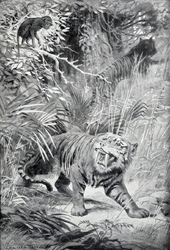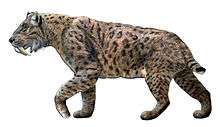Machairodus
| Machairodus Temporal range: Late Miocene to the Middle Pleistocene | |
|---|---|
| | |
| M. aphanistus skull | |
| Scientific classification | |
| Kingdom: | Animalia |
| Phylum: | Chordata |
| Clade: | Synapsida |
| Class: | Mammalia |
| Order: | Carnivora |
| Family: | Felidae |
| Subfamily: | †Machairodontinae |
| Tribe: | †Machairodontini |
| Genus: | †Machairodus Kaup, 1833 |
| Type species | |
| †Machairodus aphanistus Kaup, 1832 | |
| Species | |
Machairodus is a genus of large machairodontine saber-toothed cats that lived in Europe, Asia, Africa and North America from the late Miocene to the Middle Pleistocene. It is the animal from which the family Machairodontidae gets its name and has since become a wastebasket taxon over the years as many genera of sabertooth cat have been and are still occasionally lumped into it.
Discovery
Machairodus was first named in 1832, by German Naturalist J. J. Kaup. Though its remains were known since 1824, it was believed by George Cuvier that the fossils had come from a species of bear, which he called "Ursus cultridens" (known today as Megantereon) based on composite sample of teeth from different countries, species and geologic ages, leading to what would become a long series of complications. Kaup however, recognized the teeth as those of felids and promptly reclassified the existing specimens as Machairodus, including M. cultridens in it. The name quickly gained acceptance and by the end of the 19th Century, many species of felid or related feliform (such as nimravids) were lumped into the genus Machairodus, including but not limited to Sansanosmilus, Megantereon, Paramachairodus, Amphimachairodus, Nimravides, and Homotherium among others. This would eventually turn Machairodus into something of a wastebasket taxon, which would be rectified with the discoveries of more complete skeletons of other machairodonts.[3]
Description

Macharodus was similar in size to a modern lion, standing about 1 meter at the shoulder. The species once referred to Machairodus coloradensis was apparently significantly larger, about 1.2 m at the shoulder, according to skeletal and life reconstructions.[4] If accurate, this would have made M. coloradensis one of the largest felids. However M. coloradensis, along with M. kurteni and M. giganteus, has been reassigned to the genus Amphimachairodus and by extent, the Homotherini based on both morphology and its time of appearance in North America.[5] Nimravides catacopsis also has been separated from Machairodus, as the two are too different in regards to autapomorphies to be synonymous. [6] However, the species Machairodus horribilis, which stands as the largest known species of the genus, is comparable in size to the equally large and much later Smilodon, to which it has been compared, weighing in at around 404.6 kg (892 lb.). Its skull, measuring upwards of 16 inches in length, is the largest known skull for any machairodont.[7]
The skull of Machairodus was noticeably narrow compared with the skulls of modern pantherine big cats, and the orbits were relatively small. The canines were long, thin and flattened from side to side but broad from front to back like the blade of a knife, as in Homotherium. The front and back edges of the canines were serrated when they first grew, but these serrations were worn down in the first few years of the animal's life.
Machairodus was about 2 metres long and probably hunted as an ambush predator. Its legs were too short to sustain a long chase, so it most likely was a good jumper, and used its canines to cut open the throat of its prey. Its teeth were rooted to its mouth and were not too delicate, unlike most saber-toothed cats of the time, which had extremely long canines which hung out of their mouths. The fangs of Machairodus, however, were able to more easily fit in its mouth comfortably while being long and effective for hunting.[8] Despite its great size, the largest example of Machairodus, M. horribilis was better equipped to hunt relatively smaller prey than Smilodon, as evidenced by its moderate jaw gape of 70 degrees, similar to the gape of a modern lion.[9]
Classification
The fossil species assigned to the genus Machairodus were divided by Turner into two grades of evolutionary development - M. aphanistus and the North American "Nimravides" catacopis representing the more primitive grade, and M. coloradensis and M. giganteus representing the more derived grade.[4] However it should be noted that M. coloradensis, M. kurteni and M. giganteus are now considered species of the genus Amphimachairodus at present, reducing the number of species within the genus Machairodus.[10] Nimravides too, is now also considered its own genus, and thus N. catacopsis should also remain separate.[11] The characteristics of the more advanced grade include a relative elongation of the forearm and a shortening of the lumbar region of the spine to resemble that in living pantherine cats.[4]
Paleoecocology
Machairodus seemed to prefer open woodland habitat, as evidenced by finds at Cerro de los Batallones, which is of Vallesian age. As a top predator at Batallones, it would have hunted large herbivores of the time. Such herbivores would have included horses like Hipparion, the hornless rhinoceros Aceratherium, the gomphotherid mastodon Tetralophodon, the suid Microstonyx, silvatherid giraffes and boselaphine antelope. Machairodus would have competed for such prey with the Amphicyonid Magericyon, fellow machairodonts Promegantereon and Paramachairodus, the bear Indarctos, and the small hyenid Protictitherium. While Indarctos and Magericyon would likely have been strongly competitive with Machairodus for food, Promegantereon, Paramachairodus and Protictitherium likely were less potential rivals.[12] Based on its jaw gape, the largest species, M. horribilis was probably a hunter of relatively slow-moving horses.[13]
Pathology
Machairodus aphanistus fossils recovered from Batallones reveal a high percentage of tooth breakages, indicating that unlike later machairodonts, due to a lack of protruding incisors Machairodus often used its sabers to subdue prey in a manner similar to modern cats; this was a more risky strategy that virtually ensured that damage to their saber teeth often occurred.[14]
References
- ↑ Anton, Mauricio (2013). Sabertooth.
- ↑ Anton, Mauricio (2013). Sabertooth.
- ↑ Antón, Mauricio (2013). Sabertooth. Bloomington, Indiana: University of Indiana Press. pp. 118–119. ISBN 9780253010421.
- 1 2 3 Turner, Alan; Antón, Mauricio (1997-04-15). The Big Cats and Their Fossil Relatives. Columbia University Press. p. 233. ISBN 978-0-231-10228-5. OCLC 34283113.
- ↑ Anton, Mauricio (2013). Sabertooth.
- ↑ Anton, Mauricio (2013). Sabertooth.
- ↑ https://blogs.scientificamerican.com/laelaps/the-biggest-saber-cat/
- ↑ Legendre, S.; Roth, C. (1988). "Correlation of carnassial tooth size and body weight in recent carnivores (Mammalia)". Historical Biology. 1 (1): 85–98. doi:10.1080/08912968809386468. Retrieved 2011-06-03.
- ↑ https://blogs.scientificamerican.com/laelaps/the-biggest-saber-cat/
- ↑ Anton, Mauricio (2013). Sabertooth.
- ↑ Anton, Mauricio (2013). Sabertooth.
- ↑ Antón, Mauricio (2013). Sabertooth. Bloomington, Indiana: University of Indiana Press. p. 52. ISBN 9780253010421.
- ↑ http://www.livescience.com/56775-sabertooth-cat-bite-diversity.html
- ↑ Antón, Mauricio (2013). Sabertooth. Bloomington, Indiana: University of Indiana Press. pp. 183–184. ISBN 9780253010421.
